#i know its september so by this point a lot of northern hemisphere folks are winding down on gardening
Explore tagged Tumblr posts
Text
What to Do Once Things Are Planted?
This is my seventh post in a series I’ll be making on how to increase biodiversity on a budget! I’m not an expert--just an enthusiast--but I hope something you find here helps!
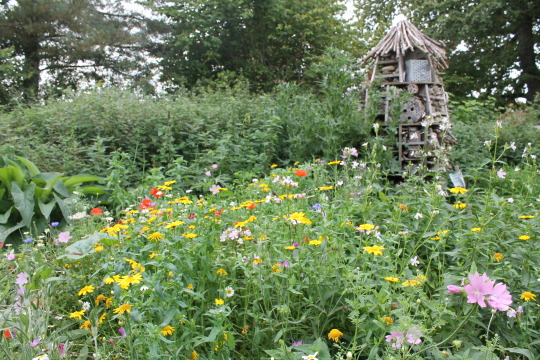
So you’ve gotten started on making a garden to boost biodiversity! 10/10, excellent work! So, now what?
First, you’ll need to keep watering the plants--especially if you’re going through a dry season. Native plants will be more acclimated to your area’s seasonal weather, but they’ll need a helping hand while they’re getting established--especially if you’re starting with young, tender seedlings. With that in mind, if you accidentally skip out on crucial watering days, don't panic! There's been tons of times where I haven't watered for an entire summer and had perennials come back the next spring! Even this year, during a heatwave, I completely did not water my swamp milkweeds, but they're already popping back up! You may also need to go in and weed, especially if you’re seeing invasive species popping up in the garden. Invasives are no good--if you do anything, do your best to get those out as effectively and safely as possible!
If you’re needing to maintain your shrubs in spring and summer, double check to make sure there are no active bird or insect nests within them. If it’s possible to wait until later to cut your shrubs, it could be extremely beneficial.
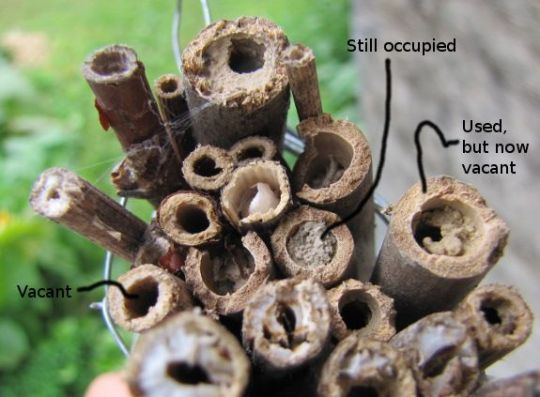
When fall and winter come around and your plants begin to die back, don’t cut them away if you can! Many insects overwinter in the plant stems left behind as perennials die back to the roots. In addition, birds will use seed heads as a source of food over the winter. Try not to clean things up until late winter/early spring, when other food sources are beginning to come back and things are growing again. By then, the insects should be waking up and leaving the plant stems as well.
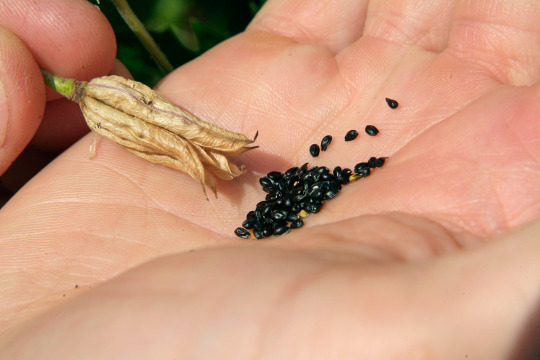
However, don’t let this discourage you from collecting seeds! Collecting seed from your plants is a great way to continue gardening at low cost, as well as making friends and encouraging others to garden by trading seeds or offering them as gifts. If you're in an area where you do need to cut back, this is a great opportunity to collect the seeds and save them for the future. You could also cut back what’s dying in the front yard and keep things to overwinter in the backyard. Some overwintering habitat is better than no overwintering habitat.
Want to know how to collect seeds from specific plants? I've found YouTube to be a great source of info for this! Knowing what you're doing and when is key to getting a viable harvest.
As your mulch begins to break down, you’ll need to keep adding more to top it off, if you can. It can get a bit repetitive, but no worries--the mulch breaking down means your soil is improving!
If possible, add to your garden! Expand, add in new things, and keep encouraging the growth of native plants. If you couldn’t add that water feature in year one, see if you can in year two! New interest in birds? Add a birdhouse, or more bird feeders. Loving the butterflies? Add plenty more nectar-rich plants, or do more research into what they lay their eggs on! Want more color? See what else you can add in! Came into some new pots to expand your flowerpot garden with? Find cool native plants to put in them! I always encourage people to start small and then expand over time, as opposed to starting big and getting overwhelmed.
Keep learning and observing native species of birds, insects, mammals, etc. See what’s coming to your yard now, and look into how you can improve things more for them on your budget. If you aren’t seeing what you were hoping, see if there’s other actions you can take that’ll attract what you’re hoping to see in your backyard habitat. Knowing more about the world around you makes it easier to know how to help the world around you. Talk to others about what you’re doing, the changes you’ve made, and the results you’ve seen! Curious neighbors? Work friends? Your closest homies? Your family? All fair game! You just might be the one who gets someone else interested in making their space a habitat for local wildlife!
That’s the end of this post! My next post is gonna be about the secret Other Thing you can do to help biodiversity--tackling invasives! Until then, I hope this advice was helpful! Feel free to reply with any questions, your success stories, or anything you think I may have forgotten to add in!
#biodiversity#solarpunk#gardening#outdoor gardening#ani rambles#out of queue#the biodiversity saga#at least it hasn't been 2 months since the last post amiright#i know its september so by this point a lot of northern hemisphere folks are winding down on gardening#buuuut winter's a good time to buy seeds for cheap! and for plotting and planning#and meanwhile the southern hemisphere will be just gearing up!#either way I hope this advice has been helpful so far!
408 notes
·
View notes
Text
TEACHING TOURISTS THE REAL HAWAI`I
New York Times - February 4, 2020
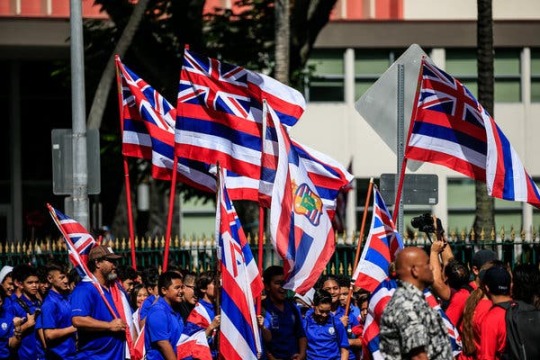
Demonstrators waving Hawaiian flags march outside Iolani Palace, marking the anniversary of the overthrow of Hawaii by the government of the United States.Credit...Marco Garcia for The New York Times
Locals in O`ahu know that the best way to get from Waikiki’s crowded beaches to the cool North Shore is to drive along the island’s eastern coast. The road is framed by mountains, ocean and greenery so lush and beautiful, it’s hard to focus the eye on one place for too long, for fear of missing the next scenic attraction.
On a recent trip along the route, something else stood out: the upside down Hawaiian flags flying at almost every stop.
The flag, which has the union jack in the bottom left corner, instead of the usual top left, hung in storefronts in Waikiki and was printed on T-shirts in Waimanalo, it was stuck on the bumpers of passing cars in Kailua and flying from the backs of trucks in Kahuku and other towns on the North Shore.
The flag has become a symbol of solidarity among Hawaiians who oppose the construction of a large new telescope on Mauna Kea, on the island of Hawai`i. Mauna Kea, at 32,000 feet from seafloor to summit, and with 13,796 feet above sea level, is one of the best places in the northern hemisphere, if not the world, to observe the cosmos, experts say. The telescope’s proponents say that it will bring hundreds of jobs to the island and advance humanity’s study of space.
But it has faced fierce resistance from some native Hawaiians for whom Mauna Kea is sacred ground and a place of roots, and their allies. Opponents of the telescope say they are tired of having their land taken for purposes that benefit others and for the often elusive promise of jobs that fail to deliver in terms of numbers or a living wage.
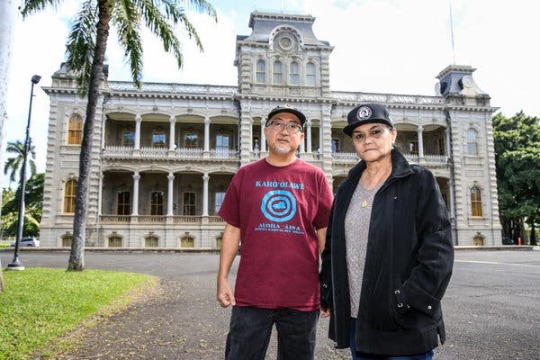
Kyle Kajihiro, left, and Terrilee Keko'olani, who offer alternative, educational tours of Oahu, outside Iolani Palace.Credit...Marco Garcia for The New York Times
“The struggle at Mauna Kea right now is one of the biggest issues that has realigned many cultural political relationships in Hawai`i,” said Kyle Kajihiro, an activist and lecturer at the University of Hawaii at Manoa. “It’s really quite an amazing emergence of Hawaiian activism of cultural awareness.”
The battle over the telescope has revealed fissures that have long existed in Hawai`i, a place that is all but synonymous with tourism — the most-popular destination for honeymoons in the United States and a bucket-list perennial. The fight has inspired actions around the islands, all relating to how land is used and who benefits from it.
The spirit of protest is most visible in O`ahu, where in Kahuku demonstrators have spent the last several months fighting the construction of eight wind turbines, each standing at 568 feet — taller than the tallest skyscraper in Honolulu. Protesters say the turbines will have adverse long term health effects on the population. The company building them says there is no evidence to support those claims and promises to bring jobs to the area. More than 160 people have been arrested there.
In southeast O`ahu, in September, 28 people were arrested trying to block the building of a park and recreation center in Waimanalo, a largely agricultural town. The developers behind the center say it will bring jobs and create a new community space, but opponents fear it will be a magnet for tourists and will destroy the forest and beach used by locals.
In Honolulu, in May, Hilton employees protested, demanding a better contract and job protections. In July, hotel employees went on strike to protest what they said were low wages and the firing of 45 workers by Diamond Resorts, an operator of multiple properties in the United States and Europe. The company said it would turn one of its hotels into a timeshare resort, which requires fewer workers than a traditional hotel.
“We value our dedicated team members at The Modern Honolulu and we were pleased to reach a contract agreement that includes a significant pay increase,” a spokesman for Diamond said. “We are continuing our planned efforts to convert the property into a world-class vacation ownership resort.”
Most people in Hawai`i, especially in the tourism industry work more than one job to barely get by, said Bryant de Venecia, communications organizer for the workers’ union, Unite Here Local 5, which represents resort workers.
“Mauna Kea has lit a fire for Hawaiians who are tired of watching their land, resources and work be used at the expense of their well-being,” he said.
Hawai`i is the most expensive state to live in, according to the 2018 Annual Average Cost of Living Index by the Council for Community and Economic Research. Groceries, for example, cost more than 60 percent the national average.
“People are tired of being decorative — Hawaiians as well as people who live in Hawai`i,” said Maile Meyer, who owns Nā Mea Hawai’i, a bookstore in Honolulu that sells products from smaller local makers. “You’re seeing a phenomenon of natives gathering again and completely finding our way back to each other as part of the solution.
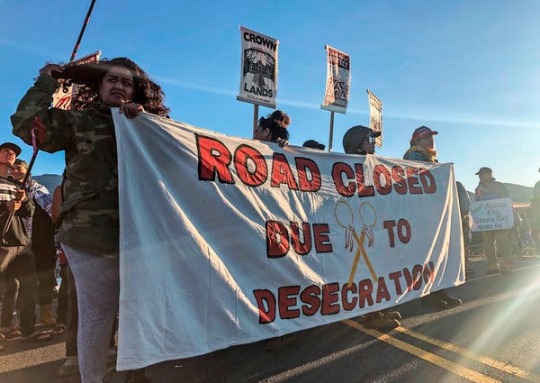
Demonstrators gather to block a road at the base of Mauna Kea, on the island of Hawa`ii, to protest the construction of a giant telescope.Credit...Caleb Jones/Associated Press
Jobs Aren’t Enough
A common thread between these protests is that they are being led by locals. They say that since Europeans first arrived in the 18th century, Hawaiian land has been taken and misused by non-Hawaiians, and often to the detriment of Hawaiians and their traditions. The endeavors that have sparked these recent protests all promise jobs, just as tourism and defense have in the past.
But perhaps for the first time in recent Hawaiian history, natives and locals are saying the quality of these jobs is not good enough.
“We’re having to move away from quantity to quality,” said Laurien Baird Hokuli`i Helfrich-Nuss, the founder of Conscious Concepts, a company that works with local organizations on sustainable tourism initiatives. “Now that local people are getting more agency, they are learning more, going into a more curious space of saying ‘It’s great that this company is providing jobs, but what kind of jobs are they? Are they good jobs? Are they paying a livable wage?”
Tourism is the biggest driver of Hawai`i’s economy, accounting for 21 percent of jobs. Nearly 10 million people visited the state in 2018 and in 2019, guest arrivals were expected to surpass that number, hitting a record high. And although more people are visiting Hawai`i, they are spending less there.
Locals say that resorts are often owned and run by non-Hawaiians, with Hawaiian people employed in the lower-paying service jobs, and that development often benefits outsiders at the expense of native and local well-being.
“There historically hasn’t been enough consideration for how tourism and tourists can contribute to making life sustainable and really livable for the locals who serve them here,” Mr. de Venecia said.
More Than A “Play Land”
The feeling of escape — of fleeing to a nearby paradise with stunning beaches and luxurious resorts — has long been Hawai`i’s appeal to the traveling public. While the hottest trends in travel now are the search for authenticity and ways to experience local life, many people who visit Hawaii are looking to get away from daily life. They come to sit on the beach and drink a matai without thinking about much else. Their interaction with local culture is often limited to watching a hula show at the hotel luau.
“We realized a lot of folks who would visit us who would normally have more consciousness about history and social justice concerns seem to turn off that part of their brain when they think about Hawai`i,” Mr. Kajihiro, the activist and lecturer, said, adding that people treat the islands as a “play land.”
But this decision to turn off their brains is hurting Hawai`i and Hawaiians, he said. While working for the American Friends Service Committee, the Quaker peace and justice organization, Mr. Kajihiro and his colleague Terrilee Keko`olani studied the environmental and social effects of colonization, militarization and overdevelopment of Hawai`i. They learned that tourism was one of the industries with some of the most damaging effects on O`ahu, he said, citing overcrowding, a higher cost of living and higher prices for goods.
The pair began offering alternative tours of the island, which they call DeTours, in 2004 and have seen increased interest in recent years. Their work was included in the recently published Duke University Press book “DeTours: A Decolonial Guide to Hawai`i,” a collection of essays, interviews and family histories about ethical and contextualized tourism in the islands.
The tours are given to groups of people who want to learn about Hawai`i from the perspective of local Hawaiians. They include a deep history on the ways military life is hidden across the island. During a typical tour, guests go to `Iolani Palace, the Hawaiian royal residence, then to Chinatown and some of the old neighborhoods where new immigrants to Hawai`i traditionally settled. The next stop is usually Fort Shafter, the headquarters of the United States Army Pacific; then Camp Smith, but the main part of the tour is Ke Awalau o Pu`uloa — Pearl Harbor.Continue reading the main sto
During a DeTours of Pearl Harbor, Mr. Kajihiro pauses in the “Oa`hu court” between the Pearl Harbor galleries and the museum and asks guests to look at the placards in the hallway. At the placard that says, “The Hawaiian Kingdom was overthrown in 1893,” he explains that this one sentence has been controversial with the United States government because it acknowledges the government-backed overthrow of Queen Lili`uokolani, which unsettles American claims to Hawai`i. In the museum’s Attack Gallery, Mr. Kajihiro points to a small image of the Hono`uli`uli internment camp where Japanese people were held during World War II and uses it as a jumping-off point for a conversation about immigration and civil rights.
“People already come here with so many images and ideas about what Hawai`i is that it’s really hard for them to see something different, so that’s why we started calling our work ‘DeTours,” Mr. Kajihiro said. “To swerve off the path that most people are going to see or understand and consume and shake it up by raising some more critical perspectives and introducing a lot of historical facts that are not so pleasant.”
New Type Of Tourism
The DeTours team is part of a movement looking to change what tourism means in Hawai`i. Ms. Nuss, of Conscious Concepts, is originally from O`ahu and returned in 2009 after working in hospitality in the Caribbean, New York, Miami and other places on the United States mainland.
“I came home seeing something happening in Hawai`i that I didn’t see when I left,” she said. “My generation was stepping into their leadership roles and doing it differently, reconnecting for a movement back to the land.”
But she quickly realized that what many companies were doing didn’t align with her vision for supporting tourism while ensuring the well-being of overworked Hawaiians.
In 2015, Ms. Nuss created her company to find ways to support Hawaiian businesses function sustainably while also remaining a key part of the most important sector in O`ahu — tourism. Ms. Nuss has worked with farms, artists and nonprofit organizations to change their offerings so they can appeal to tourists, while still benefiting Hawaiians. A farm hoping to attract tourists to volunteer might turn to her to figure out the best ways to reach them. She described her work with as “consciously creating experiences for travelers and opportunities for locals.”
“I had a realization about how our tourism industry is presently run, which is coming from the commodification of culture,” she said. “I realized what was happening in my communities and the value systems that were driving it were contradictory to the form of tourism that I was being a part of.
”Continue reading the main stTo give tourists a more authentic experience of “the real Hawai`i,” the artists Roxy and Matt Ortiz, invite them into their studio in the Kaka`ako district of Honolulu. The couple is known for their elaborate murals of fanciful tree houses, which they create under the name Wooden Wave.
“When people come see us work, it gives them a totally different way to experience Hawai`i,” Ms. Ortiz said. “And it’s a fun way for us to give tourists a different experience than they usually see in those brochures.”
In these studio visits, guests can see the couple’s work in progress, but also learn about ahupua`a, the ancient system of land division, in which the island was separated into slices, each slice running from the top of the local mountain to the shore. During the visit, Mr. Ortiz explains that each ahupua’a included forest area up high and a cultivated area below, and depending on the politics and economy of each ahupua`a, its size was different from another.
Mr. Ortiz said that even the slightest opportunity for tourists to think about how water and land have always worked together and why they hold importance to Hawaiians can encourage them to be more thoughtful when interacting with locals and the land and sea while visiting.
“When people have some of the history and context they can appreciate the art more and they can experience the island in a more meaningful way,” he said.
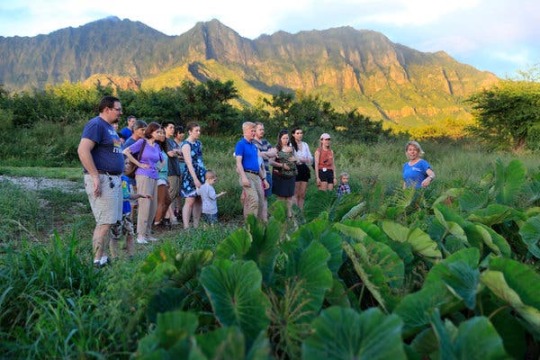
Visitors can stay at Kahumana Organic Farm to get outside the luxury resort experience.Credit...Marco Garcia for The New York Times
Another way tourists can learn about the land and engage with locals is by visiting a local farm like Kahumana Farm in Waianae on the west side of O`ahu.Continue reading the main stor
In November, Chloe Anderson, a therapist and teacher in California, visited the farm and stayed for four of her six days on O`ahu. There she shared a room with others, did yoga, learned about the produce grown and cooked on the farm and generally felt like she got a more meaningful experience than she would have at a luxury resort, removed from daily Hawaiian life.
“We had like three or four different activities we would do every day,” she said. “But so many things were based off the farm and at the farm. We still had the experience of being a tourist in Hawai`i and going on hikes and beach excursions, but also of experiencing something more.”
Some business owners are committed to staying in the tourism sector, and are trying to be as environmentally friendly as possible.
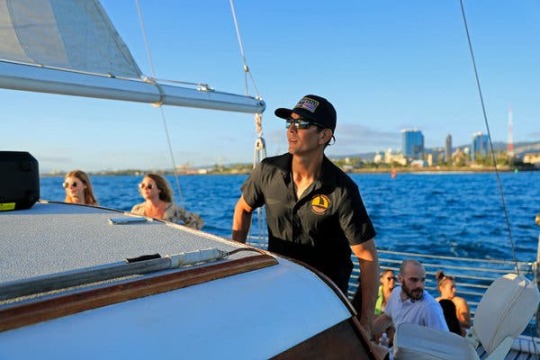
Shane Hiroshi Gibler pilots the Royal Hawaiian Catamaran, for a sunset cruise off Honolulu. Credit...Marco Garcia for The New York Times
“I don’t think it’s reasonable to expect that people just won’t work in the main industry there is and I don’t think Hawaiians want to stop tourism altogether, but we are all working to find ways of doing it responsibly and thoughtfully,” said Shane Hiroshi Gibler, who co-owns Royal Hawaiian Catamaran, which is based in Honolulu and offers snorkel tours, sunset cruises and private charters.
On Mr. Gibler’s boat, guests are asked not to bring any plastic and recycling is available aboard. Mr. Gibler educates guests an education about fishing, food and the importance of the ocean and the land to Hawaiians. The Royal Catamaran team regularly gathers people to clean up the shoreline and has been working with the Surfrider Foundation to remove ghost nets — fishing nets that have been lost or left behind by fishing boats — from reefs or the ocean.
The idea, one echoed by Mr. Kajihiro, is to encourage tourists to think about how they can leave their resort, even for one day of their trip, and contribute to the place they are visiting.ontinue reading the main stor
“The point is to make folks more responsible when they come here and to interrogate this notion that Hawai`i is somehow a place for them,” Mr. Kajihiro said. “If you are thinking about coming here, ask yourself: Who are you in relation to this place? Are you bringing something that will be of value to the host, the people who live here? What will be your impact and your legacy be?”
6 notes
·
View notes
Text
How to Plan Out Milky Way Photos
Plan your work and work your plan. That’s what… someone important once told me? Anyhow, in my opinion, planning out your Milky Way shots is absolutely one of the best ways to increase the likelihood you will be shooting bangers.
Aloha! My name is Daniel Stein, and I’m a nightscape photographer based in New Jersey.
In this article, I will be talking about how to read the weather, Moon phases, light pollution maps, and of course—the timing of the Milky Way core. While I touched upon these items in my Milky Way photography 101 tutorial, I will be going further in-depth in this article so you can really nail it down. Fear not though young citizen, everything here is super easy to follow along with.
What Do You Need to Make the Wow?
Want to hear something cool? Pretty much every tool I am about to describe is free, with a few exceptions depending on your use cases. Let’s run down one by one what I use to plan and what each tool is used for.
National Weather Service. This free website is by the most accurate way to determine if the weather is going to be good at your location of interest.
Astrospheric. This handy free web and phone app is super helpful to determine how “clear” the sky will actually be. More on that later.
Gaia GPS. This free source is great for hikers and backpackers alike. Optional if you are not into hiking, but if you are chances are you already have this. Note: to use offline features you will need a paid subscription.
The Light Pollution Map. As you probably are already aware, this free website is the ultimate way to figure out where dark skies are near you.
Planit Pro and PhotoPills. These paid tools are essential. I don’t like telling people to spend their moolah, but as you will see $10 goes a long way. Each tool has its pros and cons, and this tutorial is cross-compatible with both. Either one works, determining which one is for you will ultimately be up to what interface you think you will enjoy!
Google Maps. Last but certainly not least, this is mega helpful in determining where you want to go. Street & 360’s views are key, that way you can determine your landscape before even getting there. This is critical for planning.
Note: I am by no means affiliated nor sponsored by any of the above mentioned websites and tools.
Double note: For international folks reading this, chances are your country has a similar service to the NWS. This is most likely going to be your best bet for weather as well.
What I Do With These Things? This Is Already a Lot?
Don’t worry, we will break these down one by one. I have a very linear thought pattern so we will go through them in the order I use them.
First Things First, Determine the Darknessness
The first thing I like to do when it comes to planning my shot is determine IF it will be dark enough. I mean, come on, makes sense right? Why waste the time figuring out all of the other nonsense if the sky is going to be way too light polluted?
So, simply fire up the light pollution map. Now, if you are not already familiar with the color-coding this map uses, lemme explain real quick…
This map uses something called the Bortle Scale. Essentially, the brighter, warmer colors depict MORE light pollution with white being the brightest, while the cooler and darker colors depict less light pollution. Here is a graphic I made that correlates to this scale:
In order to photograph our galaxy, you will want to shoot for a Bortle Zone 4 or better. The darker the skies, the more potent the Milky Way will be. This is a great starting point for determining a location where you want to shoot.
Here is something you need to consider: not only does the Light Pollution in the spot where you are shooting from matter, but so does the direction you are looking towards. If you are looking towards a Core rising in the heart of a massive city, you will capture lots of light pollution on the horizon in that direction.
When to See the Core
The visibility of the Milky Way core is not consistent from one night to the next. Rather, it is determined by these factors:
Time of year
Latitude
Moon phase
The direction you are facing (which kind of goes into time of year — more on that below)
I will break these down below.
Time of Year and Direction
As briefly discussed in my Milky Way basics article, the core rises and sets at different times and directions throughout the year. Here are examples:
During “early core season” such as March, the core will rise in the very early morning such as about 03:00 due Southeast.
Early core season
During “mid peak season” such as July, the core can be seen rising once dark night has begun due at about 23:00 due South.
Mid peak season
During “late season” such as September, the core can be seen setting due Southwest just after sunset at about 21:00.
Late season
Note that these times and directions will vary slightly based on your latitude.
Oh Look, Latitude
What in tarnation is latitude? Sounds complicated. The latitude is the measurement of your location in relation to the Earth’s poles. Since, believe it or not, the Earth is indeed a sphere, think about a circle. Halfway around a circle is 180º of rotation. Latitude starts at -90º and spans to 90º. So there you go, 180º of rotation.
If you are standing at -90º, you would be on the South pole. If you are standing at 0º, you would be dead-center at the equator. Likewise at 90º, you would be directly under the North Pole with that dude who is always wearing fluffy red jackets.
We can apply this to finding the Milky Way by understanding that the latitude you plan to shoot at will affect how much dark night you actually have to work with. Think about how there is a summer and winter solstice and how they affect daylight hours. During the summer solstice in the northern hemisphere, the days are long but the nights are short. This will ultimately limit the window of time you can shoot, as will our rock buddy, the moon!
View this post on Instagram
A post shared by Dan Stein (@danieljstein)
This is a biggy and it is easy to understand why! The Moon acts as one big ol’ bucket of light in the sky that will wash out the sky during a Full Moon, but completely reveal even the faintest detail of nebula during a New Moon.
What is New Moon exactly then? Well no, the Moon is not literally new, but rather its phase is. The New Moon phase is when the location of the Moon is between the Earth and Sun. Therefore, the bright side of the Moon is facing away from us essentially makes the Moon invisible to us. Full Moon is, of course, the opposite.
The Moon transitions from New Moon to Full Moon over the course of 14 days. This is called waxing. As it transitions from Full Moon back to New Moon, it is then waning. The Moon rises in the East and Sets in the West every night, just like the Sun. Once we understand these Moon Phases, we can then apply it to our Core timing we learned above and thus realize that it does not always need to be New Moon to shoot the Milky Way Core!
In this shot for example, I captured a Waxing Crescent Moon setting on the horizon:
This means that despite the Moon Phase not being New, it was still going to set in time for me to shoot the Milky Way Core shortly afterward.
Using the Apps
At this point, you can use the above information directly in an app like PhotoPills or Planit. This will allow you to make a specific plan for a specific shot, down to the act time and focal length. That way, you can visualize your shot before you get there, thus reducing the possibility of perhaps looking in the wrong direction, or being there when the moon is too bright. This is why planning is critical. Why get to a location only to find the shot is a no-go. Plan, plan, and plan some more.
Putting All the Wow Together
So now you know how to time the Milky Way Core, let’s apply this to how I would use these tools to plan a shot.
1. Check the Light pollution Map to find your spot.
You can actually do this right in Planit or Astrospheric which is super handy!
2. Zoom out on the map to determine your surroundings. How much light pollution is going to be on the horizon? In my example, there will certainly be some.
3. Use Google Maps to figure out what your shot looks like.
If you are lucky, maybe you can drop that little dude to determine there is a street or 360º view someone took of your location, therefore figuring out what your landscape looks like. Do this side by side with Photopills or Planit to figure out the different features and what your shot may look like. Plug in your focal length and figure out if you want to shoot wide or telephoto.
4. These apps have the NPF calculator built-in, so if you are not shooting with a tracker, you can figure out your shutter speed based on your camera and focal length easy peasy!
5. Determine when you want to shoot your shot. What time of year are you going? And as a result, what direction will the Core be rising and setting to and from?
How is the light pollution on the horizon affected by this?
6. Look at the Moon phase! What time is it rising and setting?
Will the Core be visible before or after the Moon rises or sets? In my example, it looks like the Moon sets at 00:09, while the Core will already have risen. This means I would have the rest of the night to shoot! Weeeee.
7. Okay, so now we know the timing works out, but what about how to get there? Back to Google Maps for a second here. If your shot is car accessible, legally, no problem. But if you will be hiking, this is where an app like Gaia GPS will be critical for planning.
I will not get too deep into hiking basics and etiquette here as that is an entire post on its own, but regardless of where you choose to go, please leave no trace!
8. We are so close! Now it is up to Mama Nature to determine if our plan can come to life. So, let’s check the weather.
Note that this really does not become accurate until perhaps a few days out, maybe even the day of. Type in your location into the NWS site. See what the clouds are doing, and do not forget to check the wind speeds! If it is too windy, it may be too difficult to set up a tripod and get good exposures.
9. Use the forecast as an opportunity to be prepared. What clothing do you need to bring? How many layers, etc…
10. One last often overlooked step is to determine how clear the sky will actually be beyond just cloud cover. Astrospheric shines at this. You can use the map layers to determine sky transparency, as well as if there is any smoke or haze in your area.
The clearer the skies, the juicier the shot.
11. It is time. Let’s go. You worked hard for this shot. Make it happen.
So, what shots are you going to plan this year?
About the author: Daniel J. Stein is a passionate nightscape photographer working full-time in New Jersey in his family’s commercial plumbing contracting business. The opinions expressed in this article are solely those of the author. You can find more of Stein’s work on his website and Instagram. This article was also published here.
from PetaPixel https://ift.tt/3waCq7s
0 notes